atom: The basic unit of a chemical element. Atoms are made up of a dense nucleus that contains positively charged protons and uncharged neutrons. The nucleus is orbited by a cloud of negatively charged electrons.
element: A building block of some larger structure. (in chemistry) Each of more than one hundred substances for which the smallest unit of each is a single atom. Examples include hydrogen, oxygen, carbon, lithium and uranium.
engineer: A person who uses science to solve problems. As a verb, to engineer means to design a device, material or process that will solve some problem or unmet need. (v.) To perform these tasks, or the name for a person who performs such tasks.
fission: The spontaneous splitting of a large unit into smaller self-sustaining parts. (in physics) A process in which large atomic nuclei break apart to form two or more lighter nuclei. The excess mass of the parent nuclei (compared to the resulting smaller ones) is converted into energy.
fossil: Any preserved remains or traces of ancient life. There are many different types of fossils: The bones and other body parts of dinosaurs are called “body fossils.” Things like footprints are called “trace fossils.” Even specimens of dinosaur poop are fossils. The process of forming fossils is called fossilization.
fossil fuel: Any fuel — such as coal, petroleum (crude oil) or natural gas — that has developed within the Earth over millions of years from the decayed remains of bacteria, plants or animals.
fuel: Any material that will release energy during a controlled chemical or nuclear reaction. Fossil fuels (coal, natural gas and petroleum) are a common type that liberate their energy through chemical reactions that take place when heated (usually to the point of burning).
fuse: (v.) To merge two things together, often along some seam. (n.) Some cord, tube or other material that can burn and eventually ignite an explosive. Or an electrical device that breaks an electrical circuit when it overheats, thus preventing electrical wires from getting hot enough to cause a fire.
fusion: (v. to fuse) The merging of two things to form a new combined entity. (in physics) The process of forcing together the nuclei of atoms. This nuclear fusion is the phenomenon that powers the sun and most other stars, producing heat and forging the creation of new, heavier elements.
helium: An inert gas that is the lightest member of the noble gas series. Helium can become a solid at -272 degrees Celsius (-458 degrees Fahrenheit).
hydrogen: The lightest element in the universe. As a gas, it is colorless, odorless and highly flammable. It’s an integral part of many fuels, fats and chemicals that make up living tissues. It’s made of a single proton (which serves as its nucleus) orbited by a single electron.
mass: A number that shows how much an object resists speeding up and slowing down — basically a measure of how much matter that object is made from.
power plant: An industrial facility for generating electricity.
pressure: Force applied uniformly over a surface, measured as force per unit of area.
radioactive: An adjective that describes unstable elements, such as certain forms (isotopes) of uranium and plutonium. Such elements are said to be unstable because their nucleus sheds energy that is carried away by photons and/or and often one or more subatomic particles. This emission of energy is by a process known as radioactive decay.
star: The basic building block from which galaxies are made. Stars develop when gravity compacts clouds of gas. When they become hot enough, stars will emit light and sometimes other forms of electromagnetic radiation. The sun is our closest star.
sun: The star at the center of Earth’s solar system. It is about 27,000 light-years from the center of the Milky Way galaxy. Also a term for any sunlike star.
waste: Any materials that are left over from biological or other systems that have no value, so they can be disposed of as trash or recycled for some new use.








